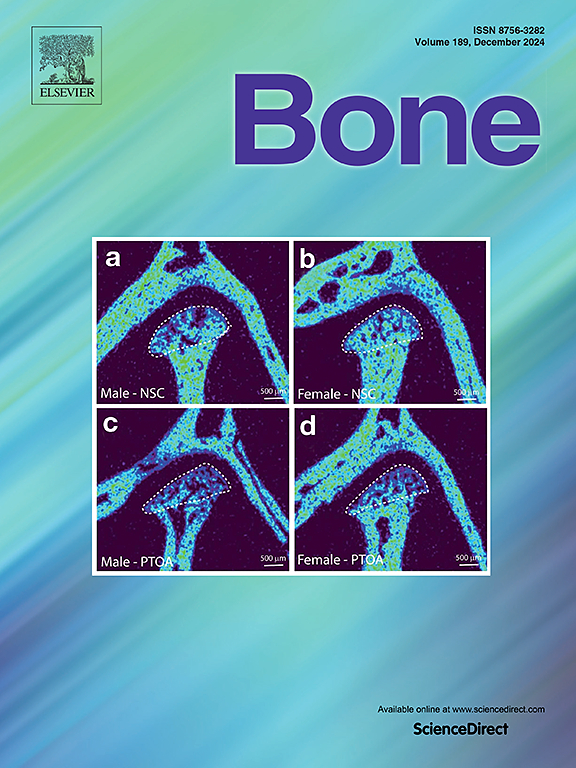RANKL 衍生肽 MHP1-AcN 通过靶向 RANK 和 TNFR1 减轻小鼠卵巢切除术诱发的骨质疏松症
IF 3.5
2区 医学
Q2 ENDOCRINOLOGY & METABOLISM
引用次数: 0
摘要
目的绝经后雌激素缺乏会增加成骨细胞中核因子- κ B配体受体激活因子(RANKL)的表达,从而促进破骨细胞的分化,并增加T细胞源性肿瘤坏死因子α (TNFα)的产生,从而诱导骨细胞中硬化蛋白的表达,从而抑制骨形成。本研究旨在开发一种新的骨质疏松解偶联治疗剂。方法制备n端乙酰化和c端酰胺化的小胶质细胞愈合肽1 (MHP1-AcN),这是一种n端乙酰化和c端酰胺化的RANKL修饰肽,缺乏破骨细胞激活CD环。考虑到RANK和TNF受体1 (TNFR1)的结构相似性,我们假设MHP1-AcN可以抑制RANKL-RANK和TNFα - TNFR1通路,从而解决骨质疏松症的病理生理问题,并在体外和体内使用卵巢切除小鼠模型进行了评估。结果在去卵巢小鼠中,MHP1-AcN抑制破骨细胞生成,降低骨细胞硬化蛋白表达,防止骨丢失,改善股骨松质骨和皮质骨微结构。与抗rankl抗体不同,MHP1-AcN显著地保存了成骨细胞的骨形成,增强了骨强度,这可以通过增加能量吸收能力来证明。在体外,MHP1-AcN同时与RANK和TNFR1结合,通过RANKL-RANK途径抑制破骨细胞活性,通过tnf α - TNFR1 -核因子- κ B途径降低硬化蛋白表达。MHP1-AcN对成骨细胞增殖分化及RANKL表达无影响。结论mhp1 - acn可有效抑制破骨细胞的发生和硬化蛋白介导的骨形成的抑制,同时可显著保持成骨细胞的功能。这些发现表明,MHP1-AcN靶向对骨稳态至关重要的双通路,是一种很有前途的骨质疏松解偶联治疗剂。本文章由计算机程序翻译,如有差异,请以英文原文为准。

RANKL-derived peptide MHP1-AcN attenuates ovariectomy-induced osteoporosis by targeting RANK and TNFR1 in mice
Purpose
Estrogen deficiency following menopause increases receptor activator of nuclear factor-kappa B ligand (RANKL) expression in osteoblasts, thereby promoting osteoclast differentiation, and enhances T cell-derived tumor necrosis factor-alpha (TNFα) production, which induces sclerostin expression in osteocytes, thereby inhibiting bone formation. This study aimed to develop a novel uncoupling therapeutic agent for osteoporosis.
Methods
We developed microglial healing peptide 1 with N-terminal acetylation and C-terminal amidation (MHP1-AcN), a modified RANKL peptide with N-terminal acetylation and C-terminal amidation lacking the osteoclast activating CD loop. Given the structural similarities of RANK and TNF receptor 1 (TNFR1), we hypothesized that MHP1-AcN could inhibit both the RANKL–RANK and TNFα–TNFR1 pathways to address the pathophysiology of osteoporosis, as evaluated in vitro and in vivo using an ovariectomized mouse model.
Results
In ovariectomized mice, MHP1-AcN inhibited osteoclastogenesis, reduced osteocytic sclerostin expression, prevented bone loss, and improved the femoral cancellous and cortical bone microarchitecture. Unlike anti-RANKL antibody, MHP1-AcN considerably preserved bone formation by osteoblasts and enhanced bone strength, as evidenced by increases in energy absorption capacity. In vitro, MHP1-AcN bound to both RANK and TNFR1, suppressing osteoclast activity via the RANKL–RANK pathway and reducing sclerostin expression through the TNFα–TNFR1–nuclear factor-kappa B pathway. MHP1-AcN did not affect osteoblast proliferation and differentiation or RANKL expression.
Conclusion
MHP1-AcN effectively inhibits osteoclastogenesis and sclerostin-mediated suppression of bone formation while considerably preserving osteoblast function. These findings suggest that MHP1-AcN, which targets dual pathways critical for bone homeostasis, is a promising uncoupling therapeutic agent for osteoporosis.
求助全文
通过发布文献求助,成功后即可免费获取论文全文。
去求助
来源期刊

Bone
医学-内分泌学与代谢
CiteScore
8.90
自引率
4.90%
发文量
264
审稿时长
30 days
期刊介绍:
BONE is an interdisciplinary forum for the rapid publication of original articles and reviews on basic, translational, and clinical aspects of bone and mineral metabolism. The Journal also encourages submissions related to interactions of bone with other organ systems, including cartilage, endocrine, muscle, fat, neural, vascular, gastrointestinal, hematopoietic, and immune systems. Particular attention is placed on the application of experimental studies to clinical practice.
 求助内容:
求助内容: 应助结果提醒方式:
应助结果提醒方式:


